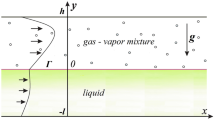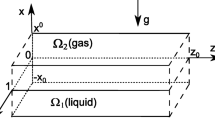Abstract
The theoretical approaches for mathematical modelling of the convective flows with mass transfer through the liquid–gas interface are discussed. The special attention is payed to modelling with use of the classical Boussinesq approximation of the Navier–Stokes equations. The diffusion equation and the effects of thermodiffusion and thermal diffusivity (the Soret and Dufour effects) are taken into account additionally to describe vapor and heat transfer processes in the gas-vapor phase. The use of the Oberbeck–Boussinesq equations allows one to apply the group-analytical methods in the theory of the evaporative convection and to construct the exact solutions of special type of the governing equations. Joint flows of the evaporating liquid and gas-vapor mixture are studied with the help of a partially invariant solution for the convection equations. The 2D and 3D solutions are demonstrated to simulate two-phase flows in the infinite channels with interface being under action of a longitudinal temperature gradient and perpendicularly directed gravity field. In the present paper the fluid flows with diffusive evaporation/condensation in the terrestrial and microgravity conditions are studied in the steady case. The new results obtained for combined thermal regime on the external rigid boundaries are presented.






Similar content being viewed by others
References
Andreev, V. K., Kaptsov, O. V., Pukhnachov, V. V., Rodionov, A.A.: Applications of group theoretical methods in hydrodynamics, p 408. Kluwer Academic Publ., Dordrecht (1998)
Bekezhanova, V.B., Goncharova, O.N.: Stability of the exact solutions describing the two-layer flows with evaporation at interface. Fluid Dyn. Res. 48(6), 061408 (2016)
Bekezhanova, V. B., Goncharova, O. N.: Modeling of three dimensional thermocapillary flows with evaporation at the interface based on the solutions of a special type of the convection equations. Appl. Math. Model. 62, 145–162 (2018a)
Bekezhanova, V. B., Goncharova, O. N.: Problems of evaporative convection (Review). Fluid Dyn. 53(1), S69–S102 (2018b)
Bekezhanova, V. B., Goncharova, O. N.: Thermocapillary convection with phase transition in the 3D channel in a weak gravity field. Microgravity Sci. Tech. 31(4), 357–376 (2019)
Bekezhanova, V. B., Kabov, O. A.: Influence of internal energy variations of the interface on the stability of film flow. Interfacial Phenomena and Heat Transfer 4(2-3), 133–156 (2016)
Bekezhanova, V. B., Shefer, I. A.: Influence of gravity on the stability of evaporative convection regimes. Microgravity Sci. Tech. 30(4), 543–560 (2018)
Bekezhanova, V. B., Goncharova, O. N., Rezanova, E. V., Shefer, I. A.: Stability of two-layer fluid flows with evaporation at the interface. Fluid Dyn. 52(2), 189–200 (2017)
Bekezhanova, V. B., Goncharova, O. N., Shefer, I. A.: Analysis of an exact solution of problem of the evaporative convection (Review). Part I. Plane case. J. Siberian Federal Univ. Math. and Phys. 11(2), 178–190 (2018)
Boltzmann, L.: Lectures on gas theory. Univ California Press, Berkeley (1964)
Bratukhin, Y.K., Makarov, S.O.: Mezhfaznaya konvektsiya (Interphase Convection), Perm State Univ. Perm. [in Russian] (1994)
Das, K. S., Ward, C. A.: Surface thermal capacity and its effects on the boundary conditions at fluid-fluid interfaces. Phys. Rev E 75, 065303 (2007)
Dyagel, D. V., Rezanova, E. V.: Mathematical modeling of flows with evaporation in a two-layer system with a thermally insulated upper boundary. Izv. Altai. Gos. Univ. 96(4), 94–97 (2017). [in Russian]
Gibbs, J. W.: On the equilibrium of heterogeneous substances. Trans. Conn. Acad. Arts Sci. 3, 108–248 (1875)
Gibbs, J. W.: On the equilibrium of heterogeneous substances. Trans. Conn. Acad. Arts Sci. 3, 343–524 (1878)
Goncharova, O. N.: Simulation of flows under the conditions of heat and mass transfer at interface. Izv. Altai. Gos. Univ. 73(1/2), 12–18 (2012). [in Russian]
Goncharova, O. N., Kabov, O. A.: Investigation of the two-layer fluid flows with evaporation at interface on the basis of the exact solutions of the 3D problems of convection. Journal of Physics: Conference Series 754, 032008 (2016)
Goncharova, O. N., Rezanova, E. V.: Example of an exact solution of the stationary problem of two-layer flows with evaporation at the interface. J. Appl. Mech. Techn. Phys. 55(2), 247–257 (2014)
Goncharova, O. N., Rezanova, E. V., Lyulin, Y.V., Kabov, O.A.: Modeling of two-layer liquid-gas flow with account for evaporation. Thermophysics and Aeromechanics 22(5), 631–637 (2015)
Goncharova, O. N., Rezanova, E. V., Lyulin, Y.V., Kabov, O.A.: Analysis of a convective fluid flow with a concurrent gas flow with allowance for evaporation. High Temperature 55(6), 887–897 (2017)
Haut, B., Colinet, P.: Surface-tension-driven instability of a liquid layer evaporating into an inert gas. J. Colloid Interface Sci. 285, 296–305 (2005)
Hertz, H.: Uber die Verdimstung der Flüssigkeiten, insbesondere des Quecksilbers, im luftleeren Raume. Ann. Phys. Chem. 253, 177–200 (1882)
Iorio, C. S., Goncharova, O. N., Kabov, O. A.: Heat and mass transfer control by evaporative thermal pattering of thin liquid layers. Comput. Therm. Sci. 3(4), 333–342 (2011)
Isachenko, M. R.: Teploobmen pri kondensatsii (Heat Transfer under Condensation), Energiya, Moscow. [in Russian] (1977)
Kabov, O.A., Zaitsev, D.V., Cheverda, V.V., Bar-Cohen, A.: Evaporation and flow dynamics of thin, shear-driven liquid films in microgap channels. Exp. Therm. Fluid Sci. 35(5), 825–831 (2011)
Katkov, V. L.: Precise solutions of some convection problems. Prikl. Mat. Mekh. 32(3), 482–487 (1968)
Knake, O., Stranskii, I. N.: Mechanism of evaporation. Usp. Fiz. Nauk 68(2), 261–305 (1959). [in Russian]
Knudsen, M.: Die maximale Verdampfungsgeschwindigkeit des Quecksilbers. Ann. Phys. Chem. 47, 697–708 (1915)
Kreta, A., Lyulin, Y., Kabov, O.: Effect of temperature on the convection flow within the liquid evaporation into the gas flow. J. Phys.: Conf. Ser. 754, 032011 (2016)
Kutateladze, S. S.: Teploperedacha pri kondensatsii i kipenii (Heat Transfer under Condensation and Boiling), MashGiz, Moscow, Leningrad. [in Russian] (1952)
Kutateladze, S. S.: Osnovy teorii teploobmena (Basics of the heat transfer theory), Atomizdat, Moscow. [in Russian] (1979)
Kutepov, A. M., Sterman, L. S., Styushin, N. G.: Gidrodinamika i teploobmen pri paroobrazovanii (Hydrodynamics and heat transfer by vaporization) Vysshaya shkola, Moscow. [in Russian] (1986)
Lame, G., Clapeyron, B. P.: Memoire sur la solidification par refroidissement d’un globe liquide. Ann. Chem. Phys. 47, 250–256 (1831)
Langmuir, I: The evaporation, condensation and reflection of molecules and the mechanism of adsorption. Phys. Rev. 8(2), 149–176 (1916)
Lyulin, Y. V., Kabov, O. A.: Evaporative convection in a horizontal liquid layer under shear-stress gas flow. Int. J. Heat Mass Transfer 70, 599–609 (2014)
Lyulin, Y., Kabov, O., Iorio, C.S., et al.: Liquids-Candidates for CIMEX-1 Experiments on ISS, in: CIMEX Meeting. Bruxelles (2009)
Lyulin, Y.V., Feoktistov, D.V., Afanas’ev, I.A., et al.: Measuring the rate of local evaporation from the liquid surface under the action of gas flow. Tech. Phys. Lett. 41(7), 665–667 (2015)
Margerit, J., Colinet, P., Lebon, G., Iorio, C. S., Legros, J.C.: Interfacial nonequilibrium and Benard–Marangoni instability of a liquid-vapor system. Phys. Rev. E. 68, 041601 (2003)
Maxwell, J. C.: Collected scientific papers, p 2. Cambridge Univ Press, Cambridge (1890)
Napolitano, L. G.: Plane Marangoni-Poiseuille two immiscible fluids. Acta Astronaut. 7, 461–478 (1980)
Ovsyannikov, L.V.: Groups and invariant-group solutions of differential equations. Dokl. Akad. Nauk SSSR 118(3), 439–442 (1958). [in Russian]
Peng, C.-C., Cerretani, C., Brown, R.J., Radke, C.J.: Evaporation-driven instability of the precorneal tear film. Adv. Coll. Interf. Sci. 206, 250–264 (2014)
Prosperetti, A.: Boundary conditions at a liquid-vapor interface. Meccanica 14(1), 34–47 (1979)
Pukhnachov, V.V.: Thermocapillary convection under low gravity. Fluid Dyn. Trans. Warszawa: PWN 14, 145–204 (1989)
Pukhnachov, V.V.: Group-theoretical nature of the Birikh’s solution and its generalizations, Book of Proc Symmetry and differential equations, Krasnoyarsk, 180–183. [in Russian] (2000)
Shliomis, M. I., Yakushin, V. I.: Convection in a two-layers binary system with an evaporation. Collected papers: Uchenye zapiski Permskogo Gosuniversiteta, seriya Gidrodinamika 4, 129–140 (1972). [in Russian]
Sivukhin, D. V.: General physics course, vol. 2. Fizmatlit, Moscow (2005). [in Russian]
Stefan, J.: Uber das Gleichgewicht und die Bewegung, insbesondere die Diffusion von Lzas gemengen, Sitzungsberichte der Kaiserlichen Akademie der Wissenschaften, Wien, 63–124 (1871)
Sterman, L. S.: On the theory of heat emission under liquid boiling. Zh. Tekh. Fiz. 23(2), 341–351 (1953). [in Russian]
Shevtsova, V.: IVIDIL experiment onboard the ISS. Adv. Space Res. 46(5), 672–679 (2010)
Weast, R.C.: Handbook of chemistry and physics. CRC Press Inc., Boca Raton (1979)
Acknowledgments
Authors gratefully thank Shefer Ilia A. for the help in the picture processing.
Author information
Authors and Affiliations
Corresponding author
Ethics declarations
Conflict of interests
The authors declare that they have no conflict of interest.
Additional information
Publisher’s Note
Springer Nature remains neutral with regard to jurisdictional claims in published maps and institutional affiliations.
This article belongs to the Topical Collection: Multiphase Fluid Dynamics in Microgravity
Guest Editors: Tatyana P. Lyubimova, Jian-Fu Zhao
This work was partially supported by the Russian Foundation for Basic Research (project No. 17-08-00291, analysis of the evaporative convection regimes in 2D case) and by the Russian Foundation for Basic Research, Krasnoyarsk Regional Fund of Science and the government of Krasnoyarsk region (project No. 18-41-242005, study of 3D flows).
Appendices
Appendix 1
When constructing the solution the case with the constant evaporation mass flow rate M = const is considered. The deceptively simple case allows one to perform the comparison with the values of M obtained in experiments and presented as trendlines (Goncharova et al. 2015).
Note that if the Dufour and Soret effects are taken into account simultaneously in boundary conditions for the temperature and vapor concentration (2.12) and (2.15), then these conditions can be replaced by equalities
Due to conditions (A.1) we have \({a_{2}^{2}} = 0\), b2 = 0 and
where coefficients E1, E2 and B1 are expressed in the following form:
Continuity conditions for the velocity and temperature (2.11) at the interface result in equalities of coefficients \({c_{3}^{1}} = {c_{3}^{2}}\), \({c_{5}^{1}} = {c_{5}^{2}}\).
Parameter \({a_{2}^{1}}\) is defined by relation \({a_{2}^{1}}= (A-A_{1})/x_{0}\) owing to linear temperature distribution (2.13) on the lower wall x = −x0.
Heat balance condition (2.8) leads to the following equalities:
where the mass flow rate of evaporating liquids is determined by relation \(M = -D\rho _{2}\left ({c_{6}^{2}}+\alpha {c_{4}^{2}}\right )\) obtained from the mass balance equation (2.9). Since \({a_{2}^{2}} = b_{2} = 0\) the first condition in Eq. A.2 implies that \({a_{2}^{1}} = 0\). Consequently, equality of the temperature gradients on the lower wall and the interface is fulfilled: A1 = A. The second condition in (A.2) allows one to express constant \({c_{4}^{1}}\):
Condition for saturated vapor concentration (2.10) has as a consequence the relations b1 = C∗ε∗A and \({c_{7}^{2}} = C_{*}\left (1+\varepsilon _{*}{c_{5}^{2}}\right )\).
Dynamic conditions (2.7) defines correlations between coefficients \({c_{1}^{1}}\) and \({c_{1}^{2}}\), \({c_{2}^{1}}\) and \({c_{2}^{2}}\):
Notation ρ and ν have been introduced in “??” (see formula (2.8)).
Integration constant \({c_{1}^{2}}\), \({c_{2}^{2}}\), \({c_{3}^{2}}\) are determined as a solution of the equation system obtained from the no-slip conditions on both walls of the channel (2.14) and additional condition (3.10):
Knowing \({c_{1}^{2}}\), \({c_{2}^{2}}\), \({c_{3}^{2}}\), constants \({c_{1}^{1}}\), \({c_{2}^{1}}\), \({c_{3}^{1}}\), \({c_{6}^{2}}\) can be calculated.
Then, constant \({c_{4}^{2}}\) is defined with the help of condition of zero heat flux on the upper wall x = x0 (the first equality in Eq. A.1):
Now value of \({c_{4}^{1}}\) can be found through known \({c_{6}^{2}}\) and \({c_{4}^{2}}\).
And finally, to define constant \({c_{5}^{1}}\) condition (2.13) is used:
It allows one to found successively \({c_{5}^{2}}\) and \({c_{7}^{2}}\).
The pressure functions pi are defined up to an additive constants \({c_{8}^{i}}\). Without loss of generality we can put the constants to be equal to zero.
Appendix 2
The physico-chemical parameters of working fluids are presented below in the order {HFE-7100, nitrogen} (or only HFE-7100) (Weast 1979; Lyulin et al. 2009):
Rights and permissions
About this article
Cite this article
Bekezhanova, V.B., Goncharova, O.N. Analysis of Characteristics of Two-Layer Convective Flows with Diffusive Type Evaporation Based on Exact Solutions. Microgravity Sci. Technol. 32, 139–154 (2020). https://doi.org/10.1007/s12217-019-09764-0
Received:
Accepted:
Published:
Issue Date:
DOI: https://doi.org/10.1007/s12217-019-09764-0




